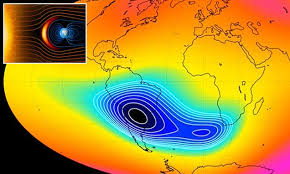Scientists have raised concerns about a significant development in the Earth’s magnetic field, an area critical to life on the planet. A region referred to as the South Atlantic Anomaly (SAA) has been identified as a “weak spot” in the Earth’s magnetic field, and recent studies suggest it is expanding. This anomaly is not just a localized phenomenon; it poses potential risks to modern technology and underscores the importance of monitoring Earth’s magnetic environment closely.
The Earth’s magnetic field, generated by the planet’s molten iron core, serves as a shield against harmful solar radiation and cosmic rays. It plays a vital role in protecting the atmosphere and maintaining conditions conducive to life. However, the magnetic field is not uniform. Variations occur due to complex geophysical processes within the Earth. The SAA is one such variation, characterized by a region of significantly weaker magnetic intensity over parts of South America and the South Atlantic Ocean.

Over the past few decades, satellite data and ground-based measurements have revealed alarming trends in the SAA. The anomaly is not only growing in size but also shifting westward. This expansion has implications for satellite operations, power grids, and even the safety of astronauts. Satellites passing through the anomaly experience increased radiation exposure, which can disrupt onboard electronics, damage sensitive components, and shorten their operational lifespan. For astronauts on missions that traverse this region, the heightened radiation levels necessitate additional protective measures.
Scientists have linked the anomaly’s growth to changes in the dynamics of Earth’s core. The liquid outer core generates electric currents that create the magnetic field through a process known as the geodynamo. Variations in core flow patterns, possibly driven by thermal and compositional differences, contribute to the weakening observed in the SAA. Some researchers suggest that the anomaly might be an early indicator of a geomagnetic pole reversal—a phenomenon where the North and South Magnetic Poles switch places. While such reversals are a natural part of Earth’s history, occurring approximately every few hundred thousand years, the process can take millennia and is not expected to happen imminently.
The implications of a weakening magnetic field extend beyond technological disruptions. A diminished field allows more solar and cosmic radiation to penetrate the Earth’s atmosphere, potentially impacting climate patterns and increasing risks for biological systems. For example, heightened radiation levels could affect migratory animals that rely on the magnetic field for navigation.
To better understand and address these risks, international collaborations have intensified efforts to study the Earth’s magnetic field. Satellite missions, such as the European Space Agency’s Swarm constellation, have provided valuable insights into the structure and dynamics of the magnetic field. These satellites measure variations in field intensity, track anomalies like the SAA, and help refine models predicting future changes.
Despite advancements in monitoring and modeling, the SAA remains a complex challenge. Scientists emphasize the need for continuous observation and improved understanding of the geodynamo process. This knowledge is crucial for mitigating the potential impacts of magnetic field anomalies on technology and society.
The following table highlights key characteristics and trends associated with the South Atlantic Anomaly:
| Aspect | Details |
|---|---|
| Location | South America and the South Atlantic Ocean |
| Magnetic Field Intensity | Significantly weaker than surrounding regions |
| Rate of Growth | Expanding westward and increasing in size over decades |
| Impact on Satellites | Increased radiation exposure, potential damage to electronics |
| Possible Link to Core Dynamics | Variations in liquid outer core flow patterns |
| Connection to Pole Reversal | Could indicate early stages, though a reversal is not imminent |
The SAA serves as a stark reminder of the interconnectedness of Earth’s systems and the need for vigilance in safeguarding technological infrastructure. While the anomaly itself does not pose an immediate threat to human health, its effects on satellites, power grids, and other critical systems warrant attention. The growth of the SAA underscores the importance of international cooperation in space weather research and the development of mitigation strategies.
In addition to technological impacts, the anomaly provides an opportunity for scientific exploration. Understanding the processes driving changes in the Earth’s core and magnetic field can shed light on the planet’s evolutionary history and its future trajectory. As researchers delve deeper into these mysteries, the insights gained could inform a wide range of fields, from geophysics to climate science.
The expansion of the South Atlantic Anomaly also raises questions about Earth’s resilience in the face of natural variations. Historically, the planet has undergone periods of significant magnetic field changes, including reversals and intensity fluctuations. These events have shaped the Earth’s environment and influenced life in profound ways. By studying the SAA and its implications, scientists can better understand the mechanisms underlying these changes and their potential consequences.
As the anomaly continues to evolve, the role of public awareness becomes increasingly important. Educating the public about the magnetic field, its significance, and the challenges posed by anomalies like the SAA can foster greater understanding and support for scientific research. Outreach efforts, including accessible explanations of complex phenomena, are essential for bridging the gap between scientific discovery and societal engagement.
In conclusion, the South Atlantic Anomaly represents a critical area of study with far-reaching implications for technology, science, and society. Its growth and potential impact highlight the need for continued research, international collaboration, and proactive measures to mitigate risks. As scientists unravel the mysteries of the Earth’s magnetic field, the knowledge gained will contribute to a deeper understanding of our planet and its place in the cosmos.










Add Comment